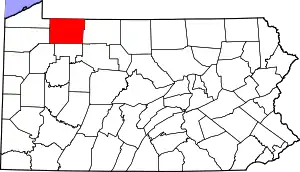.png.webp)
The Cornplanter Tract or Cornplanter Indian Reservation is a plot of land in Warren County, Pennsylvania that was administered by the Seneca tribe. The tract consisted of 1,500 acres (610 ha) along the Allegheny River.
The tract comprised the only native reserved lands within the state of Pennsylvania during its existence. It was originally established in 1796 as a grant to Seneca diplomat Cornplanter, also known as John Abeel III, for his personal use, with the right to pass the plot down through his descendants forever.[1] Cornplanter promptly opened up his plot to native settlement, and within two years, 400 Seneca were living on the tract.[2] In 1918, most of Cornplanter's descendants were killed in the 1918 flu pandemic,[3] and Jesse Cornplanter, the last male heir, died in 1957 without having children,[4] leaving the plot without ownership. The plot was already largely abandoned as a residence by the time of Jesse's death, and a 1941 map (seen at right) shows only scattered buildings on the tract.
In the early 1960s, construction of the Kinzua Dam created the Allegheny Reservoir, which submerged the vast majority of the tract. Graves located in a cemetery on the tract mostly were exhumed and their bodies were reinterred in higher ground.[5][6][7]
References
- ↑ "Chief Cornplanter". Pennsylvania Historical and Museum Commission. Archived from the original on 2015-03-07. Retrieved 2018-05-31.
- ↑ "Cayuga: Our Oral Legacy - Home. Cayuga Digital Dictionary". Archived from the original on 2012-03-26. Retrieved 2012-05-27.
- ↑ Bulletin of the New York State Museum, 1920. Section: "Death of Chief Edward Cornplanter," pages 104 and 105.
- ↑ Lester, Patrick D. The Biographical Directory of Native American Painters. Tulsa, OK: SIR Publications, 1995: 125
- ↑ "Cornplanter Cemetery - Warren County, Pennsylvania". Retrieved 2012-09-23.
- ↑ "Cemetery Flooded by the Kinzua Dam". Retrieved 2012-09-23.
- ↑ Alvin M. Josephy, Jr. (December 1968). "Cornplanter, Can You Swim?". American Heritage Magazine. Vol. 20, no. 1. Retrieved 2012-09-23.
